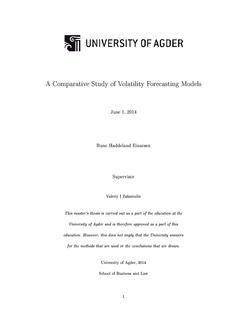| dc.contributor.author | Einarsen, Rune Haddeland | |
| dc.date.accessioned | 2014-09-16T10:40:01Z | |
| dc.date.available | 2014-09-16T10:40:01Z | |
| dc.date.issued | 2014 | |
| dc.identifier.uri | http://hdl.handle.net/11250/219866 | |
| dc.description | Masteroppgave i økonomi og administrasjon – Universitetet i Agder 2014 | nb_NO |
| dc.description.abstract | The purpose of this thesis is to investigate which of the selected models that forecasts the out-of-sample volatility most accurate and to see if the regression based models can outperform the historical volatility models. Using the data from the S&P500, NASDAQ Composite, DJIA, CBOE Interest Rate, LBMA Gold and USD/GBP return series. The data is forecasted under different distribution assumptions and then evaluated against each other. Trough this thesis, it can be con-cluded that the asymmetric GJR-GARCH under Student-t distribution most accurately describes the S&P500 and DJIA while GJR-GARCH under the normal distribution provides the most accurate forecast for NASDAQ Composite. The asymmetric EGARCH under Student-t distribution and under normal distribution most accurately describes the CBOE Interest Rate return series and the LBMA Gold return series respectively. When it comes to the USD/GBP return series the EWMA model provided the best forecast. Among the models classified as historical volatility models in this thesis only the EWMA model could compete with the asymmetric GARCH models by being the preferred model for one of the series and close in terms of MSE for the other series. | nb_NO |
| dc.language.iso | eng | nb_NO |
| dc.publisher | Universitet i Agder / University of Agder | nb_NO |
| dc.subject | BE 501 | nb_NO |
| dc.title | A comparative study of volatility forecasting models | nb_NO |
| dc.type | Master thesis | nb_NO |
| dc.subject.nsi | VDP::Social science: 200::Economics: 210 | nb_NO |
| dc.source.pagenumber | 58 p. | nb_NO |
